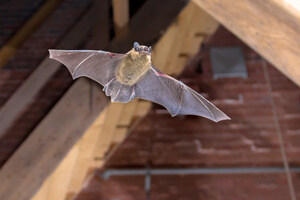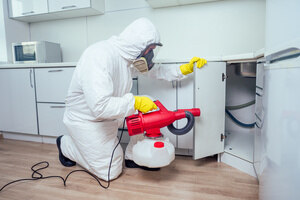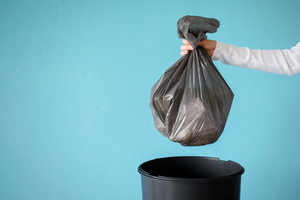Bats can cause a fair amount of damage to your home’s vulnerable areas, especially your attic. If you are dealing with bat infestation, then it is essential to have the bats safely and legally removed and all damage cleaned up to ensure the long-term safety of your home and limit the amount of damage that has been done. Below is a detailed review of the bat cleanup stage of the bat removal process.
What Is Bat Cleanup?

Bat cleanup is the process of removing and cleaning bat dropping (guano), urine, and other contaminants that bats leave behind in your home or commercial property. This is done to ensure the safety of everyone inside your property. Due to the potential dangers involved with bat cleanup, we strongly recommend working with a wildlife removal specialist to ensure safety and an effective cleanup process.
The Bat Cleanup Process
The bat cleanup process involves several steps. Your bat removal specialist should explain the process (and associated costs) to you in detail during their inspection visit. Bat cleanup typically involves the following steps:
- Assessing the extent of the damage
- Removing contaminated insulation (and other materials)
- Applying bacteria digester to affected hard surfaces
- Replacing the damaged insulation
- Removing and properly disposing of waste
Keep in mind, the cleanup process may look different for you depending on the specifics of your situations. Below is a closer look at each step of the process when you work with a bat removal specialist.
Assess the Extent of the Damage
After the bats are removed safely, your wildlife removal specialist will begin the cleanup process by conducting a full assessment of the damage. This allows them to determine the scope of the cleanup and ensure they have the right safety equipment before they begin. During the assessment, they may evaluate:
- The location
- The amount of time the bats were there
- The size of the bat colony
The inspection process usually involves a visual inspection, followed by the use of specialized equipment to identify areas of contamination that may not have been initially detected. The assessment also involves a review of any potential health risks, both short-term and long-term. Afterward, they form a strategy to ensure the area is cleaned up effectively, efficiently, and in the safest manner possible.
Remove Contaminated Insulation and Other Materials

Bats cause a fair amount of damage to all parts of the area they infiltrate. Your bat removal specialist will remove all contaminated insulation and other materials. This is a necessary step to prevent the spread of pathogens. It also paves the way for the application of bacteria digesters and insulation replacement.
Given the dangers of removing contaminated insulation without the proper gear or know-how, we strongly recommend hiring a professional for this job; most wildlife removal specialists are able to handle this stage for you after they remove the bats.
Apply Bacteria Digester to Affected Hard Surfaces
This step is often necessary to ensure optimal cleanliness of the area. Bacteria digester, which works using anerobic digestion, breaks down organic matter, including bat guano. This is a type of specialized cleaning product and helps neutralize harmful pathogens after bat infestation in your home or business.
Specifically, bacterial digesters are applied to affected hard surfaces (i.e. floors and walls), to ensure all remaining organic matter is removed and the area is disinfected. Along with bacterial digesters, professional wildlife removal specialists also clean the area thoroughly to further remove pathogens.
Replace the Damaged Insulation
If there is any damaged insulation due to the bat guano and other contaminants, then the cleanup team may suggest having the insulation replaced to further ensure the long-term safety and cleanliness of the space. The insulation replacement team can ensure the same quality insulation is used to provide optimal thermal properties. More notably, your replacement insulation should provide a tight seal that keeps bats and other birds, pests, and rodents out of the vulnerable area.
Remove and Properly Dispose of Waste

Disposing of waste from a bat infestation is not as simple as throwing it in the dumpster. There are local regulations and environmental guidelines that must be adhered to properly to ensure public safety. This is another reason why working with a professional is of the utmost importance. They understand the laws and know how to safely dispose of waste throughout the bat cleanup process.
Contact the Bat Removal and Cleanup Specialists at Spartan Animal and Pest Control
Spartan Animal & Pest Control has years of experience with bat removal and cleanup and understands how to safely and efficiently take care of a range of pest situations. Contact us today to learn more and schedule a time for an inspection and service visit.



